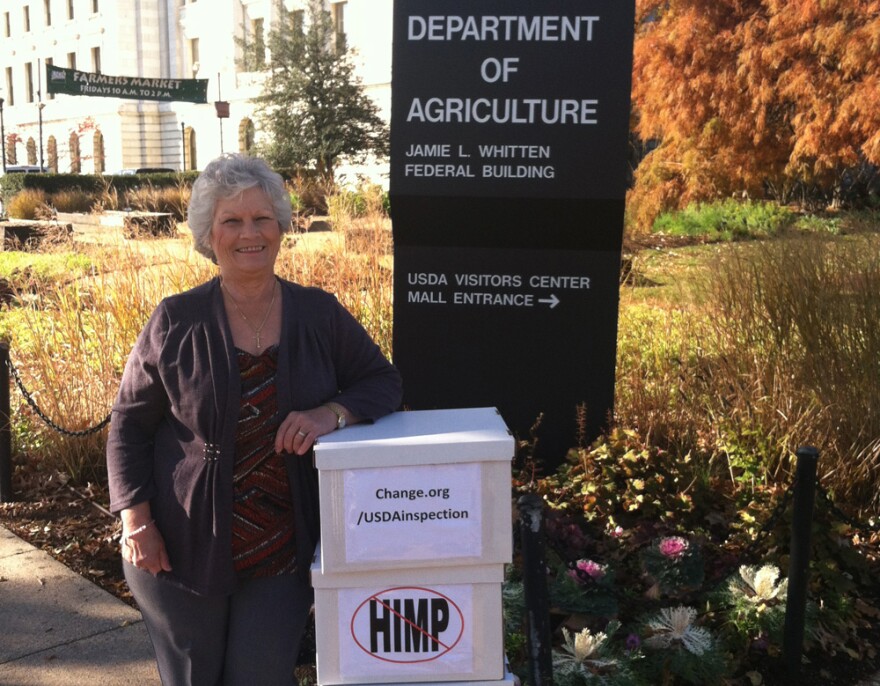Retired federal inspector Phyllis McKelvey spent 44 years looking for blemishes and other defects on chicken carcasses. She started as an inspectorŌĆÖs helper, worked her way up, and in 1998, became part of a U.S. Department of Agriculture trial.
ŌĆ£I was one of the first group of inspectors ever put on HIMP,ŌĆØ she said in an interview from her home in north Alabama.
Fourteen years later, the HIMP* inspection system is at the center of controversial proposed by the USDA for chicken and turkey processors. ItŌĆÖs all part of an attempt to modernize an inspection system that dates back to 1950s-era poultry law.
ŌĆ£We think this is a better way to protect consumers than we have done before. And thatŌĆÖs really it. It doesnŌĆÖt get more complicated than that,ŌĆØ said Elisabeth Hagen, USDA Undersecretary for Food Safety.
But from McKelveyŌĆÖs perspective, HIMPŌĆÖs streamlined inspection process would let too many unsafe chickens get by because it shifts the initial sorting of birds away from the inspector to the poultry companies themselves. Employees would remove carcasses, or parts, that are visibly unacceptable.
ŌĆ£They want to do what their supervisor says, not the right thing. If the supervisor says let it all go down the line, they let it all go down the line because thatŌĆÖs who pays them,ŌĆØ she said.
McKelvey recently delivered to USDA a petition with more than 177,000 signatures opposing the new regulations. During the formal comment period last year, more than 2,200 weighed in, with many also protesting that companies would end up controlling inspections.
The plant McKelvey worked at was one of 20 HIMP pilot locations, and data from those plants influenced the USDAŌĆÖs proposal. If enacted, the changes could affect poultry slaughter plants in 30 states, including Iowa, Nebraska and Missouri.
Plants would be required to test for pathogens, and birds would be allowed to pass by the inspector faster. The new rule also would reduce the number of inspectors on the lineŌĆöcutting federal jobs.
The National Turkey Federation and the National Chicken Council endorse the proposed rule. The groups have said it allows inspectors to focus on details that didnŌĆÖt exist when the current system was created ŌĆō and all they had was visual inspection.
ŌĆ£The time now has come to focus even more on pathogen control,ŌĆØ said Joel Brandenberger, president of the National Turkey Federation. ŌĆ£That requires significant biological testing and that is where the federal government has decided it wants inspectors more.ŌĆØ
Tom Super, a vice president at the National Chicken Council, echoed that, saying half a century ago, the physical defects on a bird were seen as the threat to public health. Now, thereŌĆÖs a better understanding.
ŌĆ£We know what could potentially make people sick, and those are things like salmonella and campylobacter,ŌĆØ he said, not bruises.
Undersecretary Hagen said show HIMP plants did as well or better than other plants on measures like salmonella rates. And they did it at a lower cost.
However, consumer groups such as the Center for Effective Government deemed the same data inconclusive.
Gynnie Robnett, coordinator of the centerŌĆÖs Coalition for Sensible Safeguards, said that in the case of one pathogen ŌĆō campylobacter -- the USDAŌĆÖs data seems to indicate there may not be much of an effect or the consequences could be disastrous.
ŌĆ£I think that level of uncertainty is just pretty ridiculous when youŌĆÖre gambling with consumersŌĆÖ health and safety and our food system,ŌĆØ she said, adding that saving money shouldnŌĆÖt be a factor in the decision.
But Hagen said in this case, efficiency and efficacy go together.
ŌĆ£ThereŌĆÖs definitely a good government component to this, being better stewards of the taxpayersŌĆÖ dollars,ŌĆØ she said. ŌĆ£But whatŌĆÖs driving it is furthering our mission and continuing to improve public health.ŌĆØ
However, the new poultry rule remains under-cooked ŌĆö still pending at the USDA. Although Hagen said itŌĆÖs a priority, no one at USDA will say when it might get pushed to the next stage in the multi-step regulatory process.
*HIMP stands for HACCP-based Inspection Models Program. HACCP stands for for Hazard Analysis and Critical Control Points, a method of identifying potential problem areas and maintaining written plans for managing the risks they present.







